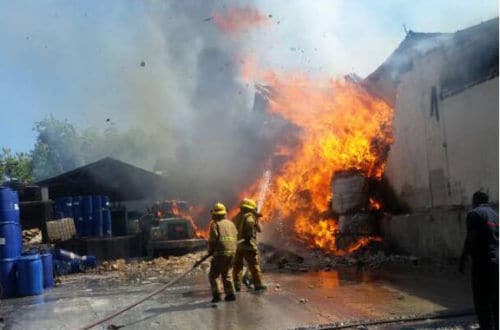Funding the Control Grid Part 1: The Biomedical Framework

By The Sharp Edge
Agencies receiving billions of taxpayer dollars have funded research that led to the Covid bioweapon and mRNA Covid injections which have proven to be more dangerous than the virus itself. These agencies have continued to support gain-of-function research and are fast-tracking mRNA technology for other vaccines and medicines including a “universal flu vaccine.”
Congress has authorized a boost in funding through the Omnibus bill and the National Defense Authorization Act of 2023 (NDAA) for the very entities responsible for the Covid catastrophe which has plagued the world. The purpose of this report is to outline the funding of agencies that contribute to the biomedical control grid condensed from 6,000 pages of legislation rushed through Congress at the end of 2022.
Through this legislation, agencies and organizations outlined in this report are tasked with preparing for the next pandemic, developing and stockpiling more mRNA injections, scaling up surveillance tools, research and development of biotechnology, and maintaining U.S. chemical and biological defense programs.
In short, the 2023 Omnibus and NDAA will expand funding of the biomedical control grid using billions of taxpayer dollars.
Watch Dig It! episode #175 for audio/video coverage of this report.
Background & Context
Agencies Involved in Gain-of-Function Research & the Origins of Covid
- Mountains of evidence now confirm that Fauci’s NIH/NIAID funded dangerous gain-of-function research through EcoHealth Alliance and the Wuhan Institute of Virology leading up to the release of the Covid bioweapon. Furthermore, there is overwhelming evidence, including Fauci’s own emails, that shows attempts by U.S. government agencies as well as the World Health Organization (WHO) to cover it up.
- The Department of Defense (DOD), Health and Human Services (HHS), State Department (USAID,) National Science Foundation (NSF), and others contributed over 120 million dollars to EcoHealth Alliance for years continuing through 2020. About one third of those contributions came directly from the Pentagon, the majority of which came from the Defense Threat Reduction Agency (DTRA), a department of the DOD that focuses on countering and deterring “weapons of mass destruction.”
- Since the release of the Covid bioweapon, U.S. government agencies and organizations including NIH, USAID and NSF have continued to fund and support EcoHealth Alliance using millions of taxpayer dollars. Despite the overwhelming evidence that U.S. agencies and organizations helped to create the Covid bioweapon, in July 2021 the Defense Department’s DTRA awarded EcoHealth a $368,000 contract through September 2024 to conduct scientific research on “combating weapons of mass destruction” and “predicting biothreat impacts.”
- In August 2022 the NSF awarded EcoHealth Alliance and Boston University a 1 million dollar grant to “predict and prevent future pandemics.” Following the partnership between EcoHealth Alliance and Boston University to “predict and prevent future pandemics,” in October 2022 Boston University published more gain-of-function research that created a deadlier Covid virus with an 80% kill rate in mice that were tested. The publication acknowledged NIH and NIAID for their contributions to this research.
Developing & Deploying mRNA Injections More Dangerous Than Covid
- In December 2019 (prior to public knowledge of the release of the Covid bioweapon) a confidential agreement signed by Ralph Baric, a key scientist connected to the origins of Covid, reveals that NIAID and Moderna agreed to transfer research specifically related to “mRNA coronavirus vaccine candidates developed and jointly-owned by NIAID and Moderna.” Based on the confidential agreements, collaboration between NIAID and Moderna on the creation of mRNA-based vaccines dates back to 2015. Furthermore, a study found genetic sequences in the Covid spike protein match genetic sequences patented by Moderna in 2016, which researchers concluded that there is only a one-in-three-trillion chance could occur naturally.
- Under a court-ordered disclosure due to a FOIA request, the FDA released a cache of 80,000 pages of Pfizer documents pertaining to approval of the Covid mRNA injection for Emergency Use Authorization. The documents reveal that Pfizer became aware of deaths and adverse events during clinical trials of the Covid jab but classified almost all adverse events, including serious ones, as “not related,” to the shots. Despite serious adverse events, the dangerous mRNA injections were approved, and even mandated for the masses.
- The latest statistics from the U.S. Vaccine Adverse Event Reporting System (VAERS), the DOD Defense Medical Epidemiology Database (DMED), excess mortality data, as well as published studies and reports have shown catastrophic increases in deaths, disabilities, illnesses, infertility, and miscarriages due to the Covid mRNA jab, confirming that the mRNA injection is much worse than the Covid bioweapon itself.
- Despite the known catastrophic adverse events related to the Covid injection, government agencies are fast-tracking the deployment of mRNA technology for other vaccines and medicines. At least 200 clinical trials are listed in ClinicalTrials.gov for mRNA-based vaccines or medicines and 50 clinical trials are currently enrolling for new mRNA-based vaccines, according to Dr. Malone. NIH-funded research is leading to the creation of a “universal flu vaccine” using mRNA technology. Both Moderna and Pfizer are in phase 3 clinical trials of their mRNA flu injections.
Expanding the Biomedical Control Grid Through Biotechnology, Digital Vaccine Passports & Perpetual Global Health Emergencies
- In March 2022, the Advanced Research Projects Agency for Health (ARPA-H) was created to conduct “high risk, high reward” research for the purposes of “developing mRNA vaccines to prevent most cancers” among several other objectives.
- A September 2022 Biden Executive Order calls for a “whole-of-government approach to advance biotechnology and biomanufacturing,” stating, “We need to develop genetic engineering technologies and techniques to be able to write circuitry for cells and predictably program biology in the same way in which we write software and program computers; unlock the power of biological data, including through computing tools and artificial intelligence; and advance the science of scale‑up production while reducing the obstacles for commercialization so that innovative technologies and products can reach markets faster.”
- In October 2022 Johns Hopkins hosted a Catastrophic Contagion tabletop exercise in partnership with the WHO and the Bill & Melinda Gates Foundation concerning a pandemic in 2025 with a “higher fatality rate than COVID-19 and disproportionately affecting children and young people.” Johns Hopkins also hosted the now infamous Event 201 tabletop exercise in partnership with the World Economic Forum (WEF) and Gates Foundation in October 2019 which predicted the Coronavirus pandemic.
- In November 2022 Biden signed the G20 Declaration, committing to “global health governance” by the World Health Organization (WHO) under “a legally binding instrument” with the intention of handing over national sovereignty to the WHO. The declaration also supports collaboration on “global digital health networks” in response to future pandemics that will “build on the success of the existing standards and digital COVID-19 certificates.”
If history is any indicator, the same entities responsible for Covid atrocities will continue their nefarious behavior with additional funding through the 2023 budget, which is outlined below.
Omnibus Bill Boosts Biomedical Control Grid Agencies
Total funding from the 2023 Omnibus bill reaches $1.7 trillion, a $134 billion increase over the 2022 budget.
- ARPA-H receives $1.5 billion, an increase of $500 million
- Assistant Secretary for Preparedness and Response receives $3.3 billion, an increase of $560 million
- BARDA receives $950 million, an increase of $205 million
- CDC receives $9.2 billion, an increase of $760 million
- FDA receives $3.5 billion, an increase of $226 million
- Global Health Programs & Pandemic Prevention receive $10.6 billion divided among the State Department with $6.4 billion and USAID with $4.2 billion
- HHS receives $120.7 billion, an increase of $9.9 billion
- NIH receives $47.5 billion, an increase of $2.5 billion
- NSF receives $9.9 billion, an increase of $1.036 billion (largest dollar increase in NSF history)
Agencies who are part of the biomedical control grid funded through the Omnibus bill are mandated to prepare for the next pandemic, funnel more taxpayer dollars towards the development and stockpiling of mRNA injections, as well as expand surveillance tools. Sections and page numbers referenced below can be found in the Omnibus bill here.
Strategic Planning for the Next Pandemic
- In Section 2001, there is no language to offer real reform of the CDC following their reckless behavior since the Covid outbreak. Instead, as part of the PREVENT Pandemics Act tucked into the Omnibus the President’s nomination for Director of the CDC must be confirmed by the Senate by January 2025 and the agency must come up with an agency-wide strategic plan to prepare for the next pandemic, known as the “CDC Strategic Plan.”
- In Section 2103, the section entitled “Public Health and Medical Preparedness and Response Coordination” outlines the duties of the Administration for Strategic Preparedness and Response (ASPR) to coordinate with all other federal agencies as well as state and local governments in response to any future so-called “public health emergencies.” Full-scale exercises on the national and state levels are required at least every 4 years.
- In Section 2104, Congress established a new pandemic czar under the President in the “Office of Pandemic Preparedness and Response Policy.” The President appoints the Director of this office. The primary function of this new pandemic czar is to provide advice to the President on preparedness and response to pandemics and any other biological threat to national security. The new pandemic czar is also tasked with coordinating all federal activities and providing strategic direction to all directors of applicable federal agencies to respond to a pandemic or biological threat to “facilitate a whole-of-Government response to such threats.” Furthermore, the new pandemic czar is mandated to assess and advise on “international cooperation” in response to such threats, as well as coordinate activities using emerging technologies “which may advance the biosecurity and preparedness and response goals of the Federal Government.”
- In Section 2235, “to address zoonotic diseases and advance public health preparedness,” HHS, CDC and other agencies are tasked with developing a mechanism for coordination across the entire federal government on a “One Health Framework.”
- In Section 7058, entitled “Global Health Activities,” funds appropriated under “Global Health Programs” allocated to the State Department and USAID are to be used for the purpose of accelerating the capacity of other countries to prevent, detect and respond to outbreaks. Additional funds in the amount of $200 million may be transferred from other programs if the Secretary of State determines that an outbreak is in our national interest to respond to a “Public Health Emergency of International Concern.” Funding of “Global Health Programs” to address pandemics is specifically restricted from use at the Wuhan Institute of Virology, but no mention under this section of limitations on funds used at other institutes like it.
Biomedical R&D, Stockpiling mRNA Injections
- On page 1009, the “National Human Genome Research Institute,” receives $663,200,000 “with respect to human genome research.”
- Also on page 1009, the “National Institute of Biomedical Imaging and Bioengineering” receives $440,627,000.
- On page 1044, the “Public Health and Social Services Emergency Fund,” allocates $1.647 billion to counter “potential biological, nuclear, radiological, chemical, and cybersecurity threats to civilian populations, and for other public health emergencies.” Through September 2024, $950 million remains available to BARDA for “advanced research and development” of countermeasures or “qualified pandemic or epidemic products.” From these funds, $75 million is made available for the “development, production and distribution of vaccines, therapeutics and other medical countermeasures” through September 2024. Products purchased under this section must be deposited in the Strategic National Stockpile.
- On page 1046, additional funds are provided in the amount of $335 million to respond to a flu pandemic. Of those funds, $300 million is available for the development and purchase of flu vaccines, antivirals, medical supplies, diagnostics and “other surveillance tools.” There is no mention of the “Flu Vaccine Act,” in this section but Senator Markey boasted that $270 million in funding was secured through the Omnibus under the “Flu Vaccine Act,” for the research and development of a “universal flu vaccine,” which is essentially a flu mRNA injection.
- Also on page 1046, Congress authorizes funding for the new ARPA-H in the amount of $1.5 billion to be used towards grants and contracts for advanced research projects related to health through September 2025. Furthermore, in Section 2331, the functions of ARPA-H are outlined, including language intended to allow ARPA-H independence from other agencies, creating an agency with little transparency or accountability while promoting “high-risk, high-reward” research to “foster the development of novel, breakthrough, and broadly applicable capabilities and technologies to accelerate transformative innovation in biomedical science and medicine in a manner that cannot be readily accomplished through traditional Federal biomedical research and development programs or commercial activity.”
- On page 1307, under the section entitled “Global Health Programs,” $4.165 billion is allocated to USAID in part for immunization programs as well as preparing for and responding to emerging global health threats in other countries. Funds appropriated under this section may be made available for contributions to Bill Gates’ GAVI Vaccine Alliance “and to a multilateral vaccine development partnership to support epidemic preparedness.”
- In Section 2301, entitled “Accelerating Research and Countermeasure Discovery” and “Fostering Research and Development and Improving Coordination,” a new section of the “Public Health Service Act” has been inserted which is entitled, “Research Centers for Pathogens of Pandemic Concern.” In this newly inserted section, a collaboration between institutes, centers, and divisions of NIH, ASPR, and BARDA is mandated for the purposes of “a multidisciplinary research program to advance the discovery and preclinical development of medical products for priority virus families and other viral pathogens with a significant potential to cause a pandemic.” The funds appropriated in this section are to be used towards grants, contracts and agreements for the research and development of new medical technologies including “platform technologies.” (The term “platform technologies” can be used to describe mRNA technology without actually stating “mRNA” in the Omnibus bill. For perspective, a keyword search of the Omnibus produces zero results for “mRNA” whereas “platform tech” appears throughout the Omnibus bill 40 times.)
- In Section 2311, entitled “Improving Biosafety and Biosecurity,” and “Improving Control and Oversight of Select Biological Agents and Toxins,” new procedures for reporting and mitigating threats “in the event of the release, loss, or theft of an agent or toxin,” from HHS or federal laboratories are outlined.
- In Section 2312, entitled “Strategy for Federal High-Containment Laboratories,” the Director of the Office of Science and Technology Policy is tasked with establishing a strategy for management, maintenance, and oversight of federally owned Biosafety Level 3 and 4 labs. Included in the strategy, the director must outline a summary of plans for determining if capacity should be expanded and a “description of how the Federal Government will address rapid changes in the need for such capacity within each relevant Federal department or agency during a public health emergency.”
- In Section 2313, a “National Science Advisory Board for Biosecurity” is mandated to provide guidance to federal agencies related to biosafety and biosecurity oversight which includes oversight of “federally-conducted or federally-supported dual use biomedical research.” (The term “dual use” refers to pathogens that can be used for both scientific research as well as bioweapons.)
- In Section 2315, entitled “Federally-Funded Research with Enhanced Pathogens of Pandemic Potential,” the Director of the Office of Science and Technology Policy is expected to review, update, and provide oversight for policies related to the federal funding involved in “the creation, transfer or use of enhanced pathogens of pandemic potential.”
- Also in Section 2315, entitled “Limitations on Countries of Concern Conducting Certain Research,” HHS is restricted from funding research “conducted by a foreign entity at a facility located in a country of concern… involving pathogens of pandemic potential or biological agents or toxins.”
- In Section 2321, entitled “Preventing Undue Foreign Influence in Biomedical Research,” and “Foreign Talent Recruitment Programs,” NIH personnel who are engaged in intramural research are prohibited from participating in foreign talent recruitment programs, though exemptions may be approved by NIH. As for extramural research, participation in foreign talent recruitment programs must be disclosed prior to receiving biomedical research funding through HHS.
- In Section 2401, entitled “Modernizing and Strengthening the Supply Chain for Vital Medical Products,” the “Public Health Service Act,” is amended to include language for “activities to support, maintain, and improve domestic manufacturing surge capacity and capabilities, as appropriate, including through the utilization of advanced manufacturing and platform technologies, to increase the availability of products that are or may become qualified countermeasures or qualified pandemic or epidemic products.” (As mentioned above, the term “platform technologies” can be used to describe mRNA technology without actually stating “mRNA” in the Omnibus bill.) Funds awarded under this section may be used to ensure domestic manufacturing capabilities that support the “rapid manufacture of countermeasures… to prepare for or respond to an existing or potential public health emergency or otherwise address threats that pose a significant level of risk to national security.” Funds appropriated under this section increased from $610 million for each year from 2019-2021 to $750 million for each year from 2022-2023.
- In Section 2409, entitled “Grants for State Strategic Stockpiles,” and “Pilot Program to Support State Medical Stockpiles,” grants or cooperative agreements must be awarded to no less than 5 states distributed among various geographical locations “to establish, expand, or maintain a stockpile of appropriate drugs, vaccines and other biological products, medical devices, and other medical supplies… to respond to a public health emergency.” The funds appropriated for this pilot program are $3.5 billion.
- In Section 2501, entitled “Enhancing Development and Combating Shortages of Medical Products,” and “Accelerating Countermeasure Development and Review,” the approval and authorization of drugs that are considered “countermeasures” may be expedited in the event of any “domestic, military, or public health emergency or material threat.”
- In Section 2503, entitled “Platform Technologies,” the Federal Food, Drug, and Cosmetic Act is amended to include language regarding platform technologies that are part of drugs or biological products. This section appears to expedite the approval process of mRNA technologies for other vaccines and medicines based on data previously submitted to the FDA using the same platform technologies as the Covid mRNA injections. Under this section, actions may be taken to “expedite the development and review of an application for a drug that incorporates or utilizes a designated platform technology,” including the consideration of “data previously submitted that is relevant to establishing, as applicable, safety or efficacy.”
Scaling Up Surveillance Tools
- On page 1046, $335 million is allocated to prepare for an influenza pandemic (as mentioned above.) Of those funds, $300 million is available to develop and purchase vaccines, medical supplies and for “other surveillance tools.” No specifics mentioned in this section on the surveillance tools that will be implemented.
- In Section 2001, requirements for the “CDC Strategic Plan” mentioned above include “enhancing global and domestic public health capacity, capabilities, and preparedness, including public health data, surveillance, workforce, and laboratory capacity and safety.”
- Also in Section 2001, under the CDC Director’s duties, “the Director may enter into transactions other than a contract, grant, or cooperative agreement for purposes of infectious disease research, biosurveillance, infectious disease modeling, and public health preparedness and response.”
- In Section 2211, entitled “Improving State, Local, and Tribal Public Health Data,” and “Modernizing State, Local and Tribal Biosurveillance Capabilities and Infectious Disease Data,” HHS is expected to collaborate with state, local and tribal public health officials to integrate and update public health data systems and networks that “reflect technological advancements.” HHS must “implement applicable lessons learned from recent public health emergencies to address gaps in situational awareness and biosurveillance capabilities.’’ HHS is required to take measurable steps to further develop medical data sharing capabilities in coordination during a “public health emergency” with state, local, and tribal public health officials as well as with “other entities with expertise in public health surveillance.”
- In Section 2212, entitled “Genomic Sequencing, Analytics, and Public Health Surveillance of Pathogens,” HHS is directed to support collaboration related to “genomic sequencing of pathogens, including the use of new and innovative approaches and technology for the detection, characterization, and sequencing of pathogens, to improve public health surveillance and preparedness and response activities.”
- In Section 2824, entitled “Genomic Sequencing, Analytics, and Public Health Surveillance of Pathogens Program,” HHS in coordination with CDC and NIH is directed to “strengthen and expand activities related to genomic sequencing of pathogens, including through new and innovative approaches and technology for the detection, characterization, and sequencing of pathogens, analytics, and public health surveillance, including… identify the potential use of genomic sequencing technologies, advanced computing, and other advanced technology to inform surveillance activities and incorporate the use of such technologies, as appropriate.”
Defense Budget Authorizes Billions Towards Biotechnology, Biowarfare & Biodefense
Total authorizations from the 2023 NDAA reaches $858 billion, an increase of $80 billion over the 2022 defense budget.
- Biological Technology, Research & Development receives $346.8 million
- Biotechnology for Materials, Research & Manufacturing receives $197.8 million
- Biotechnology Manufacturing Institutes receive $300 million
- Biomedical Technology receives $114.7 million
- Small Business Innovative Biological Research receives $5.1 million
- Subtotal of Biotechnology R&D, Manufacturing reaches $964.4 million
- Biological Threat Reduction receives $225 million
- Chemical & Biological Warfare / Defense receives $1.3 billion
- Medical Materials / Biological Defense Equipment receives $5.5 million
- Subtotal of Chemical & Biological Warfare / Defense reaches $1.5 billion
Defense projects that are part of the biomedical control grid authorized by the NDAA are tasked with preparing for the next pandemic, scaling up biotechnology research, development, and manufacturing, as well as maintaining U.S. chemical and biological warfare and defense programs. Sections referenced below can be found in the NDAA here.
Strategic Planning for the Next Pandemic
- In Section 5559, entitled “International Pandemic Preparedness,” and “Global Health Security and International Pandemic Prevention, Preparedness and Response Act of 2022,” the Global Health Security Agency (GHSA) is tasked with elevating “global health security as a national level priority… to facilitate national capacity to comply with and adhere to—” the WHO’s International Health Regulations (IHR), the UN Security Council Resolution 1540, the Biological Weapons Convention, and the “Global Health Security Agenda 2024 Framework.”
- In Section 5561, entitled “Enhancing the U.S.’ International Response to Pandemics,” and “Leveraging U.S. Bilateral Global Health Programs for International Pandemic Response,” funds authorized under this section may be used for countries receiving foreign aid for the purposes of “strengthening vaccine readiness… reducing vaccine hesitancy… delivering and administering vaccines,” as well as strengthening supply chains, improving workforces for pandemic preparedness, enhancing public health data, increasing screening and testing, and scaling up laboratory capacity.
- In Section 5562, entitled “International Pandemic Prevention and Preparedness,” and “U.S. International Activities to Advance Global Health Security and Diplomacy Strategy and Report,” the President is responsible for developing and advancing a strategy to improve global health security for pandemic preparedness. The strategy must advance the “One Health” approach, the “Global Health Security Agenda,” and the WHO’s International Health Regulations. Furthermore, the strategy must strengthen linkages between programs including efforts by the World Bank, the WHO, the Global Fund and GAVI Vaccine Alliance.
- Also in Section 5562, the “U.S. Coordinator for Global Health Security,” section discusses the establishment of a new bureau under the State Department called the “Bureau of Global Health Security and Diplomacy,” in which the Coordinator and Ambassador-at-Large for Global Health Security will coordinate and advance U.S.’ interests in pandemic prevention and response.
- Further down in Section 5562, the “Coordination for International Pandemic Early Warning Network,” section directs HHS, CDC, the State Department and USAID to work with the WHO to “establish or strengthen effective early warning systems, at the partner country, regional, and international levels, that utilize innovative information and analytical tools and robust review processes to track, document, analyze, and forecast infectious disease threats with epidemic and pandemic potential.”
- Again in Section 5562, under the section entitled “Public Health Emergencies of International Concern,” HHS and the State Department are tasked with working with the WHO to adopt an approach toward assessing infectious disease threats under the WHO’s IHR to identify and communicate levels of risk leading up to and throughout the WHO Director General’s declaration of a “Public Health Emergency of International Concern,” including sharing public health data, securing emergency funding, and conducting emergency simulations.
- Section 5563, entitled “Financial Intermediary Fund for Pandemic Prevention, Preparedness, and Response,” outlines the objectives of this newly established fund by donor nations, the UN and the WHO in September 2022 to build up capacity in areas of global health security as well as pandemic prevention and response. The fund is intended to accelerate compliance with the WHO’s IHR and with the Global Health Security Agenda 2024 Framework, in alignment with efforts by the World Bank, the WHO, the Global Fund, and the GAVI Vaccine Alliance.
- In Section 5913, entitled “National Distributed Ledger Technology Research and Development Strategy,” the Director of the Office of Science and Technology Policy is tasked with creating a national strategy to support research on distributed ledger technologies with government applications that may include “medical information management,” as well as digital identity, financial services, and digital credentials, as covered in this Corey’s Digs report entitled “National Strategy to Develop Distributed Ledger Technology for Digital ID Tucked into 2023 Defense Budget.”
- In Section 7304, under the heading of “Global Catastrophic Risk Management Act of 2022,” within one year, agencies across the federal government are required to coordinate on a report of “global catastrophic and existential risk” to include estimates of “cumulative global catastrophic and existential risk in the next 30 years,” as well as the likelihood of their occurrence and the potential sequence of events. Under this section, global catastrophic events are described as “severe global pandemics, nuclear war, asteroid and comet impacts, supervolcanoes, sudden and severe changes to the climate, and intentional or accidental threats arising from the use and development of emerging technologies.”
Scaling Up Biotechnology, Maintaining Biowarfare & Biodefense Programs
- In Section 215, entitled “Support for Research and Development of Bioindustrial Manufacturing Processes,” the Secretary of Defense is tasked with developing a network of bioindustrial manufacturing facilities to expand capacity to produce bioindustrial materials that support national security or supply chains. ‘‘Bioindustrial manufacturing’’ is defined in this section as “the use of living organisms, cells, tissues, enzymes, or cell-free systems to produce materials and products for non-pharmaceutical applications.” However, the DOD’s BioMADE project, whose mission is to “enable domestic bioindustrial manufacturing at all scales,” is currently collaborating with Johns Hopkins, Boston University and others to advance “biomanufacturing platforms and technologies for rapid, cost-effective, distributed domestic manufacturing of antigens to use in testing and medical treatments of coronaviruses.”
- In Section 861, entitled “Strategy for Increasing Competitive Opportunities for Certain Critical Technologies,” the Secretary of Defense is mandated to submit a comprehensive strategy for increasing competitive opportunities for U.S. companies’ transition of “critical technologies” into “major weapons systems and other programs.” Biotechnology is listed under the category of “critical technologies” along with quantum science technology and artificial intelligence.
- In Section 1671, entitled “Cooperative Threat Reduction Funds,” $354,394,000 is authorized to be appropriated by the DOD for funding of the Department of Cooperative Threat Reduction Program. Biological threat reduction makes up $225,000,000 or 63% of the total authorized under this section, while all other threat reduction programs under this section combined (including chemical and nuclear) make up 33% in the amount of $116,593,000. Of the total threat reduction funding under this section, $12,801,000 or 4% is unaccounted for or unspecified.
- Sections 4101-4701 outline and itemize the 2023 defense budget. Funding for biotechnology research, development, and manufacturing under these sections reaches over $964 million, while funding for chemical and biological warfare and defense programs reaches $1.5 billion.
- In Section 6505, the Director of National Intelligence is required to assess the progress of China’s global competitiveness in areas related to biotechnology as well as artificial intelligence, cloud computing and high-performance computing.
In Summary
Despite overwhelming evidence that our own government agencies helped to fund the creation of the Covid bioweapon as well as the deadly Covid mRNA injections, the very same government agencies received a major boost in funding to continue dangerous and unethical research, produce more mRNA injections, and expand surveillance tools and mechanisms for control. By my estimation, agencies and programs funded through the Omnibus bill and NDAA that contribute to the biomedical control grid received somewhere in the ballpark of $150 billion. While the Omnibus bill does attempt to provide some oversight of dangerous research as well as restrict funding of research of pathogens in “countries of concern,” Congress has done nothing to address a complete moratorium on funding gain-of-function research elsewhere.
Over the past year and going into 2023, we have seen the creation of new agencies, offices, and bureaus to expand this biomedical control grid, such as the founding of ARPA-H, the creation of a pandemic czar in the new Office of Pandemic Preparedness and Response Policy under the President, and the establishment of the new Bureau of Global Health Security and Diplomacy under the State Department. Advancing risky research in biotechnology, streamlining and consolidating control for a whole-of-government approach to the next “public health emergency,” and coordinating with international organizations to create mechanisms for global control appear to be the objectives of these new entities.
Some of the projects outlined in this report focus on a timeframe in or around the year 2024, such as the Global Health Security Agenda 2024 Framework. This timeframe coincides with the next presidential election, which draws comparisons to the release of the Covid bioweapon during the 2020 presidential election cycle. Also, by May 2023 or May 2024 the WHO aims to finalize and adopt their legally binding pandemic treaty at the World Health Assembly which would give the WHO more power in response to the next so-called “global health emergency.”
In summary, the 2023 budget enables the same perpetrators of the Covid catastrophe to advance and expand their biomedical control grid.
Although the Omnibus bill and NDAA both passed through Congress and were signed by Biden, this is not where the story ends. In fact, the fight has only just begun. New House Rules championed by the Freedom Caucus during the election for House Speaker could bring substantive change to the ways spending bills are passed in the House. The new rules include “cut-as-you-go” requirements to halt bills that increase mandatory spending, limitations on increasing direct spending through the reconciliation process, a requirement for single-subject appropriations bills, the termination of any unnecessary programs or agencies that have not been authorized by Congress, as well as constraints on raising the debt limit and taxes. Furthermore, the new House Rules reinstate the “Holman Rule,” which “allows amendments to appropriations legislation that would reduce the salary of or fire specific federal employees or cut a specific program.”
Now it is time to see if these new changes to the House Rules will rein in reckless spending. It is up to citizens to hold their representatives accountable by making their voices heard in mass. Restraining and defunding programs that violate civil liberties, drive the country to the brink of economic collapse, and expand this biomedical control grid must be a top priority in 2023.
Continue to Part 2: The Psychological Framework

Subscribe to Corey’s Digs so you don’t miss a Dig!











6 Comments
Salty
This is such an amazing report, overwhelming, but full of the info we MUST face and confront. Your skills at putting info like this together never cease to amaze me. Thank you for your never-ending devotion to exposure and truth. Here’s to hoping and praying it wakes and empowers more people to take a stand, and to push back on these destructive agendas!
Corey Lynn
Thanks so much! Edge actually put this one together. She did a fantastic job!
rachel
We are constantly told how terrible Russia is and has been,,,yet there is now a “pandemic czar” appointed?
I will die from laughing before anything else.
Donna
Wow, Thank you for Digging up all this information. I dont understand how the American people can vote for these politicians who in my opinion are literally handcuffing them and digging their graves? Republicans are not who people think they are. I mean they signed off on this Omnibus Bill giving all that money away to such Evil, corrupt entities. Entities in bed with the WEF narratives that can and will destroy the US.
The bill also includes that all new vehicles will have KILL Switches in them! So gee, if they dont like what you say, or do or refuse to do? They cut off your vehicle. That’s what the future looks like. Then add all these vaccines and bioweapons, the future looks mighty grim. Time to move out of the US and try to find a country not involved with the UN- WEF. Where is it? Because the US is No Free country. It hasn’t been for many decades now and getting worse every day.
Sherry Biglow
Corey, I sent you an email asking about the safety the Novavax jab. I know it is not an Mrna vaxx, but since I don’t trust any of their jabs, I find it hard to believe it is any safer than the others. My son let his radiation therapist talk him into taking it. He had a major 4 1/2 hr. surgery in October of last year for cancer of his esophagus. It was a very successful surgery and he has done very well in his recovery. 8 cant tell you how upset I was when he told me about taking this vaxx. He has not taken any of the MRNA jabs. Thank you for all you and your team do and for all the articles and videos you have done for us. May God Bless you and your team.
Dianne
DONNA, who posted January 14, to say Rapublicans signed off the the budget bill is inaccurate…if you do some checking, think you’ll find NONE (or very few Republicans) who approved it!! Remember who had control of the House and Senate last year…it certainly wasn’t Republlicans. Perhaps you can blame them for what happens in next years’ budget though!!